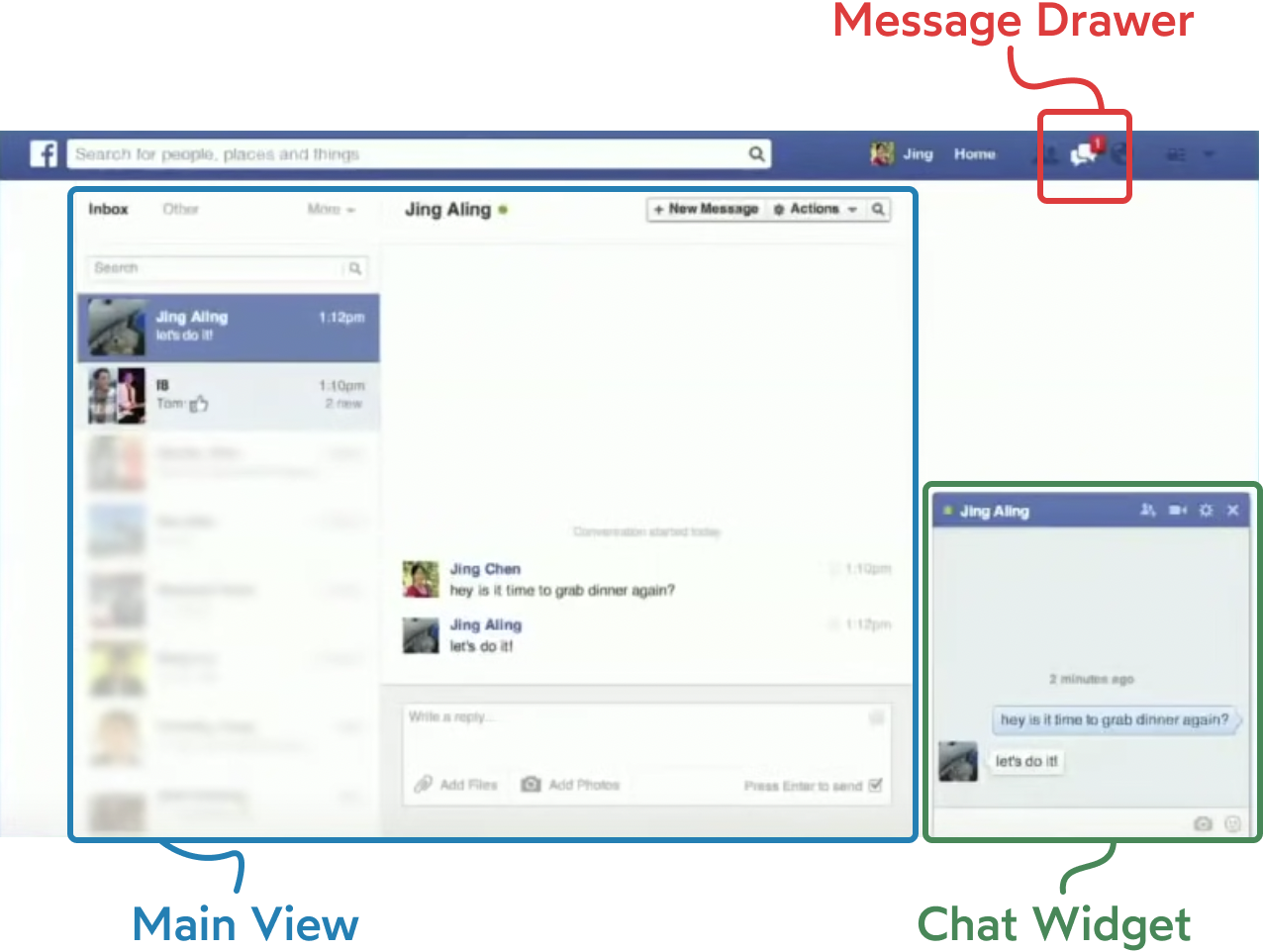Unlocking the Power of React: Top Benefits for Modern Web Development
 Yusuf Uysal
Yusuf Uysal
React has been the most popular UI library for nearly a decade, significantly simplifying the lives of frontend developers. To become better React developers, and better software engineers in general, we should always ask "why," not just focus on "how" things work. Let's take a quick journey to understand why React came about in the first place and discover the magic behind it.
The Birth of React: Solving Facebook's Synchronization Issues
In a complex app like Facebook, the bugs might not be as easy to solve as they seem. In the early 2010s, the Facebook team faced a bug where users received unnecessary notifications for messages that had already been read.
The reason for this was that multiple views in the app displayed the messages, but they were not synchronized with each other. Over time, these kinds of bugs increased and became harder to manage. React was born as an internal tool developed by Facebook to solve these synchronization problems permanently.

The “Magic” Behind React
React is powerful and popular because it keeps our state and UI in sync, minimizing the need for manual updates. Developers describe the desired UI state, and React efficiently manages the changes to the DOM to reflect that state. This declarative approach is more convenient and less complex compared to traditional imperative programming, where developers manually manipulate the DOM.
Why Use React Over Plain JavaScript: Key Advantages
Nowadays, a significant portion of web applications use React or other frameworks instead of plain JavaScript. The reason for this is very clear. If you decide to build your app with JavaScript, you most likely end up in a situation where everything is messy and hard to maintain, especially if the application is large-scale. Here are the top benefits of using React instead:
1. Component-Based Architecture
React is built upon reusable components that can be either functional or class-based, each managing its own state. This modular approach allows for code reusability, making applications more organized and easier to maintain compared to manually recreating similar structures with plain JavaScript.
2. Efficient DOM Updates
In dynamic web applications, DOM manipulation is required to reflect state changes. In plain JavaScript, this process can be expensive and slow, especially as the application grows in complexity. React optimizes this by using a Virtual DOM, which is a lightweight copy of the actual DOM. React updates the Virtual DOM first and then uses a process called reconciliation to compare it with the actual DOM. A diff algorithm determines the minimal changes needed, allowing React to update only the necessary parts of the DOM, making updates more efficient and improving application performance.
3. State Management and Hooks
A significant milestone for React was the introduction of hooks in version 16.8, which allow developers to write stateful logic in functional components, reducing the need for class components. Hooks like useState and useReducer make it easier to manage component state in a clear and concise way, compared to handling state with plain JavaScript where more boilerplate code is typically required.
4. JSX Syntax
React uses a syntax extension called JSX (JavaScript XML), which allows developers to write HTML-like code within JavaScript. JSX simplifies the process of defining the structure of the user interface and makes it easy to combine JavaScript logic with HTML elements. While it is similar to HTML, JSX is ultimately converted into JavaScript code that uses React.createElement, making it a powerful tool for creating dynamic and interactive UIs.
5. One-Way Data Flow
In React, data flows in a unidirectional manner, from parent to child components via props. This makes components simpler and more predictable because props are immutable and read-only. Any changes or updates are managed through state or callbacks passed from parent components, which maintain control over data flow. This unidirectional data flow simplifies debugging and reduces the complexity compared to bidirectional data binding often seen in other frameworks or plain JavaScript.
6. Strong Community and Ecosystem
React is supported by a large, active community that constantly contributes to its growth. This means there are plenty of resources, helpful libraries, and tools available to make our development process smoother. Whether you’re dealing with a tricky bug or just looking for advice, the React community has your back with solutions and best practices.
7. Server-Side Rendering (SSR)
React can also handle server-side rendering (SSR) with the help of frameworks like Next.js. This can give our apps a speed boost and make them more SEO-friendly by rendering pages on the server before they reach the user’s browser. Faster load times and better search engine visibility are big wins for any web app.
8. Unified Development with React Native
One of the coolest things about React is that it doesn’t just stop at web development. With React Native, we can use the same React skills to build mobile apps for iOS and Android. This makes it easier to dive into mobile development without starting from scratch and lets us create cross-platform apps with a consistent look and feel.
Resources
"React Fundamentals: The Magic of React." Accessed from Joy of React
Cover Image: React JS Development Service - IndiaMART
Facebook Annotated Chat UI: "React Fundamentals: The Magic of React." from Joy of React
Conclusion
React has revolutionized web development by addressing the complexities of traditional JavaScript. Its component-based architecture, efficient DOM updates, state management with hooks, JSX syntax, and one-way data flow make it a powerful tool. Additionally, React benefits from a strong community, supports server-side rendering, and offers a unified development experience through React Native. By simplifying state and UI synchronization, React enhances performance and makes code more maintainable and scalable, helping developers create dynamic, responsive, and robust web applications.
Subscribe to my newsletter
Read articles from Yusuf Uysal directly inside your inbox. Subscribe to the newsletter, and don't miss out.
Written by

Yusuf Uysal
Yusuf Uysal
𝗗𝗿𝗶𝘃𝗲𝗻 𝗙𝗿𝗼𝗻𝘁𝗲𝗻𝗱 𝗗𝗲𝘃𝗲𝗹𝗼𝗽𝗲𝗿 with extensive experience in JavaScript, React.js, and Next.js. I help companies enhance user engagement and deliver high-performance web applications that are responsive, accessible, and visually appealing. Beyond my technical skills, I am a 𝗰𝗼𝗹𝗹𝗮𝗯𝗼𝗿𝗮𝘁𝗶𝘃𝗲 𝘁𝗲𝗮𝗺 𝗽𝗹𝗮𝘆𝗲𝗿 who thrives in environments that value continuous learning and innovation. I enjoy projects where I can leverage my expertise in 𝗿𝗲𝘀𝗽𝗼𝗻𝘀𝗶𝘃𝗲 𝗱𝗲𝘀𝗶𝗴𝗻, 𝗯𝗿𝗼𝘄𝘀𝗲𝗿 𝗰𝗼𝗺𝗽𝗮𝘁𝗶𝗯𝗶𝗹𝗶𝘁𝘆, 𝗮𝗻𝗱 𝘄𝗲𝗯 𝗽𝗲𝗿𝗳𝗼𝗿𝗺𝗮𝗻𝗰𝗲 to deliver seamless user experiences. I get excited about opportunities where I can contribute to creating dynamic, user-focused applications while working closely with cross-functional teams to drive impactful results. I love connecting with new people, and you can reach me at yusufuysal.dev@gmail.com.